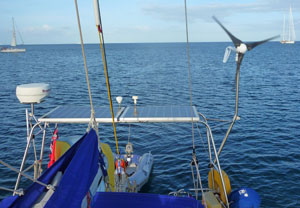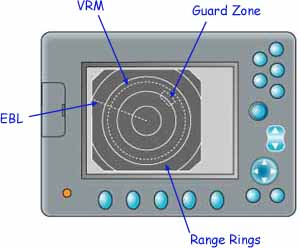- Home
- Electronics & Instrumentation
- Small Boat Radar
Is A Small Boat Radar Setup Worth Having?
It was quite a few years ago that I fitted a small boat radar system on my boat, Alacazam. A silly omission really, as I was at that time making regular trips across the English Channel, one of the world's busiest shipping lanes.
 The Radome was offset to minimise its shadow on the solar panels
The Radome was offset to minimise its shadow on the solar panelsIt wasn't just the cost - although that did come into it - but the thought of all the battery juice that the system would suck up.
But in the process of designing a new gantry for her stern, it seemed wise to build in the facility for one in the future, along with the stern light, solar panels, windcharger, wifi enhancer, GPS and NAVTEX antennas.
It wasn't long before the future caught up with me, and a radar scanner appeared in its allotted space.
But What is Radar and How Does it Work?
Radio Detection And Ranging (RADAR) is used at sea detect the presence of objects ('targets') at a distance, and to detect their speed if they are moving. It works by transmitting radio pulses, then detecting the echoes of these pulses from objects within the range of the pulse, and displaying them graphically as targets on the display.
 The radar range is restricted by curvature of the earth
The radar range is restricted by curvature of the earthBeing a line-of-sight device, maximum range is limited by the curvature of the earth and depends on the height of the scanner and the height of the target, as shown here.
Functionality of a Typical Small Boat Radar System
Its primary function a small boat radar system is as an aid to avoiding collision, but here's what else the display can do....
- Zoom - A typical sailboat radar unit will have a maximum range of 24nm and will zoom down to 1/8nm. Larger, open array scanners will have a 48nm range. Short range scales are best suited as you approach coastlines and anchorages, providing greater detail of echoes close to your boat. Long range scales provide the best overview of your boat's position relative to land masses, large ships and squalls.
- Mini Automatic Radar Plotting Aid (MARPA) - For this collision avoidance system to be effective, accurate data of your boat's heading, speed over the ground (SOG) and course over the ground (COG) must be inputted to the radar. MARPA will track up to 10 targets and will activate an alarm if any one of them is considered to represent a collision risk.
 A typical RADAR display
A typical RADAR display- Range Rings - Range rings are the concentric circles displayed on screen at pre-set distances, and centred at your boats position. They're used to estimate distance between points on the display. The distance between them changes with the zoom level, typically 1/16nm at 1/8nm range and 4nm at 24nm range.
- Guard Zones - These are areas relative to your boats heading that can be set manually. If a target enters the zone an alarm rings. The areas set can be either a sector or a circle, as shown in the sketch.
Broadband Radar Systems
Broadband radar systems are advanced radar technologies that use Frequency Modulated Continuous Wave (FMCW) technology instead of traditional pulse radar. This allows them to transmit and receive signals simultaneously, providing a clearer and more detailed representation of the surrounding area. Here are some key features:
- Close-Range Clarity: Unlike traditional radar, broadband radar excels at detecting objects at very close range without blind spots.
- Energy Efficiency: These systems consume less power, making them ideal for smaller vessels or energy-conscious users.
- Instant Start-Up: They don't require a warm-up period, offering immediate functionality.
- Low Radiation: Emitting less radiation than a mobile phone, they are safer to install in various locations.
- Enhanced Safety: With features like MARPA (Mini Automatic Radar Plotting Aid) target tracking, they improve situational awareness and collision avoidance.
Broadband radar systems are ideal for small boats, consuming less power and emitting lower radiation levels. These systems are perfect for energy-conscious sailors relying on batteries and solar panels.
Weather Detection Features
Far offshore and away from shipping lanes, you could be forgiven for thinking that small boat radar is largely superfluous.
Not so. Some radar systems now come equipped with Rain Mode, which can distinguish between rain and other radar targets.
This was borne out to us (Mary and I) on an Atlantic crossing when we discovered that during the hours of darkness, the radar will detect approaching squalls from long range (providing they have rain in them), often giving you time to adjust the course to avoid them completely—or, at worst, to just suffer a glancing blow.
Radar Scanners for Small Boat Radar Systems
There are two types of scanners:
- Radomes which are best suited for sailboats, RIBs and small power boats;
- Open Arrays which have a higher power consumption and are most frequently seen on larger power boats.
Typically, Radomes will be either 18" or 24" across, inside of which will be a 4kW transmitter giving the radar the capability to detect targets out to a maximum range of 48 nautical miles.
Coupled to a compatible multi-function display unit, the radar screen can be viewed independently or overlaid on the chart plotter screen.
On a sailboat, the scanner would normally be mounted either on the mast at a height of around 15 feet above the deck, or on a stern gantry.
With the boat boat heeled, the range of the scanner - particularly on the leeward side - will be adversely affected if mounted on the mast. However, a self-leveling mast mount will ensure that the unit's performance remains unaffected by the angle of heel.
Gantry-mounted setups, while easier to install, may obstruct the radar's field of view.
Got any radar-related questions that aren't addressed above? If so, you'll probably find the answers here...
Recent Articles
-
Modern Boat Electronics and the Latest Marine Instruments
Dec 20, 25 05:27 PM
Should sailboat instruments be linked to the latest boat electronics as a fully integrated system, or is it best to leave them as independent units? -
Hans Christian 43: Classic Bluewater Cruiser & Liveaboard Sailboat
Dec 10, 25 04:37 AM
Explore the Hans Christian 43: a legendary heavy-displacement, long-keel sailboat. Read our in-depth review of its specs, design ratios, and suitability for offshore cruising and living aboard. -
Planning Your Sailboat Liveaboard Lifestyle: An Ocean Sailor's Guide
Dec 06, 25 05:18 AM
Seasoned sailors share their methodical risk analysis for planning a secure Sailboat Liveaboard Lifestyle, covering financial, property, and relationship risks.












